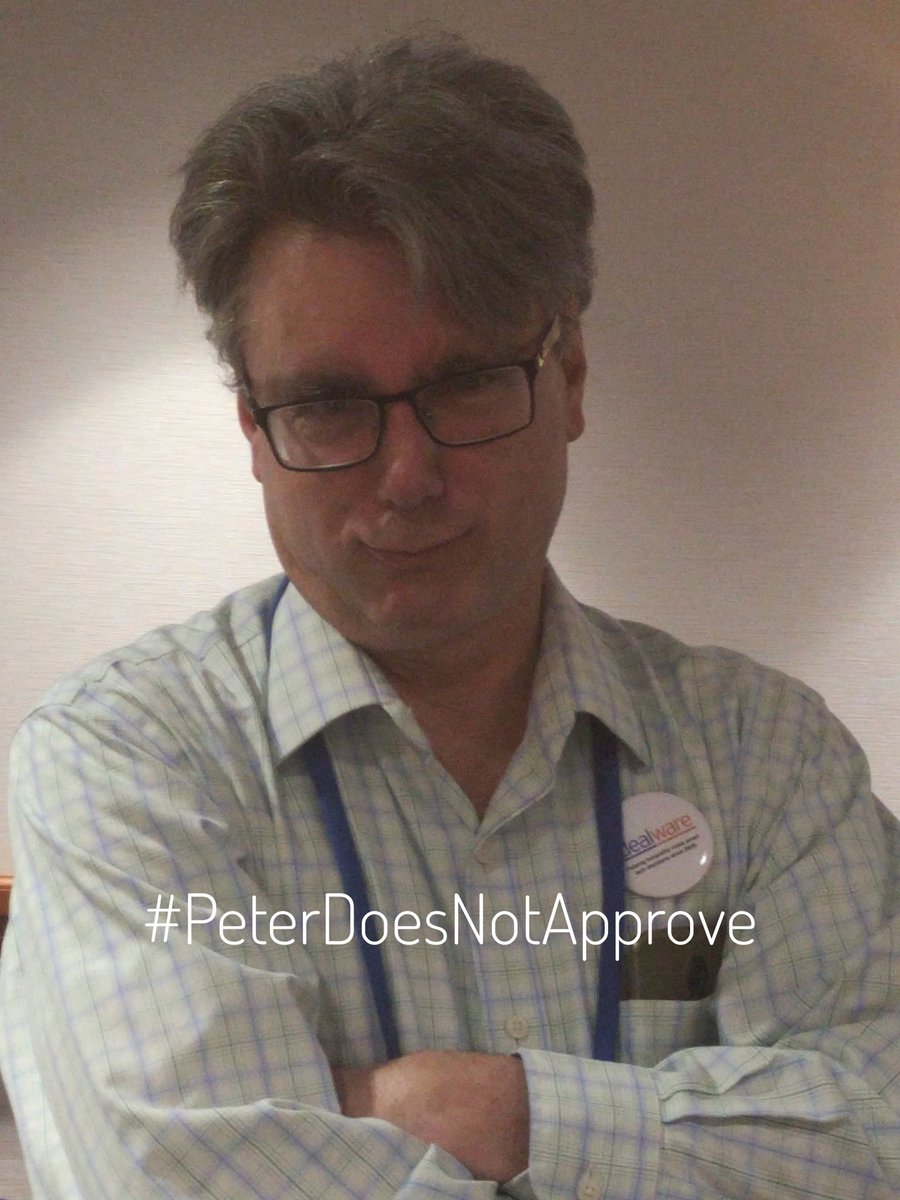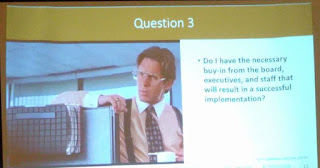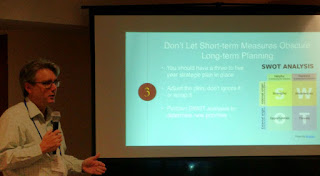 Another year, another amazing NTEN NTC! It came and went so fast! It was one of my favorites because I took more time to spend with some of my favorite Nonprofit Techies!
Another year, another amazing NTEN NTC! It came and went so fast! It was one of my favorites because I took more time to spend with some of my favorite Nonprofit Techies!Each year I follow in the inspiring example of Peter S. Campbell by sharing what I learned at the NTEN Nonprofit Technology Conference. Be sure to read Peter's Post. And here is the Peter meme we tried to start this year.
But to start, here are a few awesome overheard quotes:
- "I'd love to play with your API."
- "if your exec director loves your website, you did something wrong."
- "if all of your file names end with "file really really final-final version.xls" you probably need better document management"
- don't be ashamed to say you don't know how to use a tool or do something, we have all been there.
Weds, March 22
#NTCBeer!
#17NTC #NTCBEER was awesome! Started with dinner with some long time friends and continued with some awesome brews and conversation making for a great night. This is a can't miss event if you come to the conference.
#17NTC #NTCBEER was awesome! Started with dinner with some long time friends and continued with some awesome brews and conversation making for a great night. This is a can't miss event if you come to the conference.
Thurs, March 23
Ignite Plenary!There were less Ignites at the plenaries this time. A few were great, a few seemed like commercials. Here are a few highlights.
- starts with fail story of pricing change from vendor. Yikes! Tip know what you need & make it sustainable
- so many fail stories start with learning "that has been done" but we decide to recreate it anyway, cuz we are unique
- know your strength & value, don't fear collaboration & good software takes a team (not just cute boyfriend)
- I feel like Clay Aiken, always coming in 2nd place.
- fail story about ridiculous 7 stage, multi hour, meal eating & chart quiz. Ehhh wrong answer, security will escort u out
- we all need bad experiences to show us what we really want & where we should be. Learn from failure.
- how we react to failure is often more important than trying to avoid it.
Real World Business Analytics in Action
 |
| Live BI demo using Tweets |
- sometimes you have to start with what you have for analytics, even if it is bad & in numerous places
- tools like data warehouse & BI rock but we can't get funding for it to prove it is worth it
- often first 15 seconds of looking at dashboard is all it takes for people to determine if it has value to them
- visuals on a dashboard matter, they tell stories & create interest

Live BI demo with worldbank.org data - predictive tries to guess future, prescriptive tries to control it
- typically 5% create the reports, 95% use them. Today's BI allows direct report BI creation to end user
- enjoyed the laughter when Microsoft presenter asked about using Bing... Have fun with who you are
- www.WorldBank.org has free datasets available for your analytics
- combining bubble size & y axis & x axis with allowing chart to change with time tells a real story (see image to right)
- gone are the days where your only data source is your internal database. Think social & so many others
- cleaning the data before BI reporting can be tedious. get the right tool & spend the time tho, it is worth it
With so many different payment methods, it can be cumbersome and confusing to think about which methods you should or can accept and how secure your donor data is through these methods.
- when thinking about mobile payments, consider your end goal (donations, events, engagement) & hire the data will be available to you
- consider what countries you will work in: payment methods, phone & tools will be different
- digital wallets can dramatically increase the speed off making a donation. You don't have to fill out the donor info
- text to give donation typically $5-$10, stats show higher donation with mobile wallet. But you tend to get more new donors with text to pay.
- do your research on the platforms your supporters use before you select your mobile payment strategy. Analytics from website can help to determine what the makeup of your current supports is
- know how pictures will get cropped when shared, if your logo/message is only on the bottom it won't show when shared
- you can now add donation functionality to your videos on YouTube & your Facebook page
- I wonder if by spending our time on social media & mobile do we get tech distracted & miss talking to people...
- find change agent, need tech capability, be nimble, get data-permissions, legal risk & manage expectations
- before going crazy with mobile payments, start with a good website with solid online fundraising to learn what works
- key is to capture donations at moment you have supporters interest & attention, time kills conversions
The Role of Technology in Managing the Operations of a Nonprofit
I co-presented this session with Peggy Duvette from NetSuite and Kelly Bleach from the American Foundation for the Blind. It was a fun session with Legos and Jenga. Plus there was a lot of great content. Feel free to check out the preso slides and the shared notes: https://docs.google.com/document/d/13duIVZAk_u8iXAKSIUGvN3tQXsAUQfmfdvAhQ11_YOQ/edit
 Fri, March 24
Fri, March 24
The Fully-Informed Approach to Calculating Return on Investment
How can one determine whether an investment is worthwhile? How can we align our spending more tightly with our objectives? What tools and strategies support the formation of reasonable assumptions on the likely return on investment?
Visit the Collaborative notes for this session with the slides!
Visit the Collaborative notes for this session with the slides!
Mostly went to this because Peter Campbell presented and I always make sure to make time in my schedule to heckle him, but he is super smart! And Peter did not disappoint, it was awesome.
- Getting the right buy in is always key! (Love the humor-slides from @peterscampbell ! see images to right)
- to really get ROI realized, you have to follow up & ensure solution gets implemented & used
- when ROI is about staff- using a survey before/after change can be effective to show change
- Measure ROI in $ when you can, but list all benefits you can't monetize to see if those benefits are worth cost
- ROI is unique to your org= your staff skills, existing tools, expertise & other are all factors in cost/benefit
- always consider the staffing changes needed for ROI! Will it work for your existing staff & if not.... (changes in staff, positions or training will be required.)
- EVERY technology decision is a business decision! Know the impact of those decisions!
- we need to be good stewards of $. Do the ROI work & research on your decisions.
- combining ROI (return on investment) & TCO (total cost of ownership) can be powerful info
- often patterns of cost & trends can also inform your ROI (staff retention, system usage, # of workarounds)
- ROI can depend on knowing difference between Output (we help them get a job) & Outcome (no longer in poverty)
- assessments are great when used correctly. But self assessments only work if you know yourself & are honest about it.
- sometimes assessments are more effective when questions are asked across org, not completed by just one person? Multiple perspectives really adds value

Leading in Uncertain Times
These are uncertain times in many ways, but one uncertainty many nonprofits can relate to is funding changes (which seem to be a big topic right now). Peter and Dahna did amazing navigating this discussion and leading the crowd to some energetic conversation. I have never seen so many people like a session with three slides on layoffs.
Visit the Collaborative notes!
This interactive panel discussion featured nonprofit execs sharing how strategic assessments changed their organizations.
Visit the Collaborative Notes!
We'll review the steps involved in moving an organization to full workflow automation, including technical steps and organizational buy-in. We'll also cover ways to ensure that automated workflows are accessible to individuals with different technical skills.
Visit the Collaborative Notes!
FUN!
I got to go all Office Space with Peter Campbell and Dahna Goldstein!
And had the wackiest, loudest and best conference dinner ever with Lindsay Bealko, Marc Baizman, Tim Lockie and Marisa!
Visit the Collaborative notes!
- It seems that the only certainty today is uncertainty. So how do we handle it? big hint-get ahead of the crisis
- Never let a good crisis go to waste! @dahnag (love her & this thought)
- during uncertain times, keep mission & strategic plan as compass. And don't wait for a crisis if you see it coming.
- Be Carefully responsive! Don't overreact. Listen. Pay Attention. Be aware. Support and show you care-understand
- As a leader, set the tone. Communicate. Be direct, but sensitive. Have a clear message.
- Leaders are trained to leave emotion at home. But uncertainty=ANXIETY! Be aware of this & be proactive on it.
- Uncertain times (crises) can be awesome opportunities to start a different conversation with your funders.
- Say to funders: "you have seen the uncertainty in the news, we appreciate your support, but we need to change." – use this as a way to ask for operations funding – not restricted or as a way to ask them for more.
- during short term crisis don't let it Street you from your long term goals. Strategic plans are key, just adjust
- be honest but not create fear. find the balance of reality and hope.
- if executives aren't transparent, the rumor mill will take over. Lead by being open, don't hide it.
- leaders might think "talking about it creates panic", but reality is silence is often worse.
- never forget about the role of the Board during uncertain times.
- transparency is key in uncertain times, but don't feed rumor mill. APPROPRIATE level of candor & tone

- Hope isn't a strategy. Have a plan. Setting direction & being able to share it helps address uncertainty.
- Brainstorm w/ key players at uncertain time on worst case scenario vs likely, then plan for it. assess risk
- Having a conversation before you absolutely need to have that conversation goes a very long way.
- in uncertain times, don't hesitate to renegotiate with vendors, it is better than just losing you
- avoid big risks in uncertain times, but great time for small experiments. necessity is mother of invention.
- find other orgs in similar uncertain times so your leadership has a peer to talk-commiserate with
- when majority of budget is staff, so in crisis layoffs can be necessary. Don't avoid the conversation internally
- when dealing with layoffs, involve the right people. Make decisions on impact & position, not the people.
Sat, March 25
Nonprofit Execs Talk about Strategic AssessmentThis interactive panel discussion featured nonprofit execs sharing how strategic assessments changed their organizations.
Visit the Collaborative Notes!
- we aren't getting things done, so let's just work harder & longer! Yep, that will fix it. not.
- our staff have been here a long time ="institutional knowledge"... Otherwise known as, "we are set in in our ways."
- we've always done it that way & now we need a better system to keep doing it the same way. not.
- how do you move from being band-aid applier to silo destroyer? A strategic assessment may help.
- often staff want to make real change but are so buried in what they do that they just can't change
- we're getting by & things are fine, why change? That is actually the easiest time to improve, rather than after a crisis
- we don't like assessments, just like we don't like looking in a mirror.
- we all think we want an assessment, but we fear or don't want to face the results or make the hard changes
- a HUGE outcome of assessments is the conversation that happens during Discovery. Let's make our org GREAT AGAIN!
- your staff wants to be heard & provide strategic input. An assessment gives them that chance.
- a solid strategic assessment can take 2 weeks, 8 hours a day, to give each dept-staff time to talk=an investment
- scale the time/scope of a strategic assessment to match your org size, culture, needs, etc. Not one size fits all
- during an assessment, you will find things that you didn't even know your org or staff does.
- an assessment is only as good as the changes & actions you take based on it.
- staff can't think past what they do today. just saying think outside the box doesn't help. Lead them with questions.
- Avoid having managers in room while staff provide their insight in an assessment, it will be more direct & honest
- if your system doesn't work the way you want, ask yourself should I change how I work?
- assessment is done, review results w/team. What is important to change, can be changed & celebrate what you change
- create a budget for change based on the assessment & set aside time to make the changes or just don't bother
- NOT everything from an assessment has to go through your board, just make the operational changes needed.
- Peeling back the layers of the onion to see how bad we actually smell... Reasons to do strategic assessment
- helps to take the time to have staff review the assessment report to verify it is what they meant.
We'll review the steps involved in moving an organization to full workflow automation, including technical steps and organizational buy-in. We'll also cover ways to ensure that automated workflows are accessible to individuals with different technical skills.
Visit the Collaborative Notes!
- why do we design new reports to match the spreadsheet we used to use but hated....?
- automation isn't just about those massive efforts, think about those 10 minute tasks you do every week, they add up
- know when to automate. A 10 minute task you do quarterly which would take a week to automate isn't best idea
- Automation can be (and often is!) hacky. Might not be beautiful. Goal is to make it work for you.
- if process has alot of copy/paste or waiting to click next between steps, then it might be a good one to automate
- let me repeat. See if you can use the systems you already have better, before just running out because you saw some new awesome tool
- before you automate, document the process/flow (even just using post-its on the wall
- adding a map to a dashboard or report will always make people cheer, but who cares if it doesn't tell a story
FUN!
I got to go all Office Space with Peter Campbell and Dahna Goldstein!
And had the wackiest, loudest and best conference dinner ever with Lindsay Bealko, Marc Baizman, Tim Lockie and Marisa!



